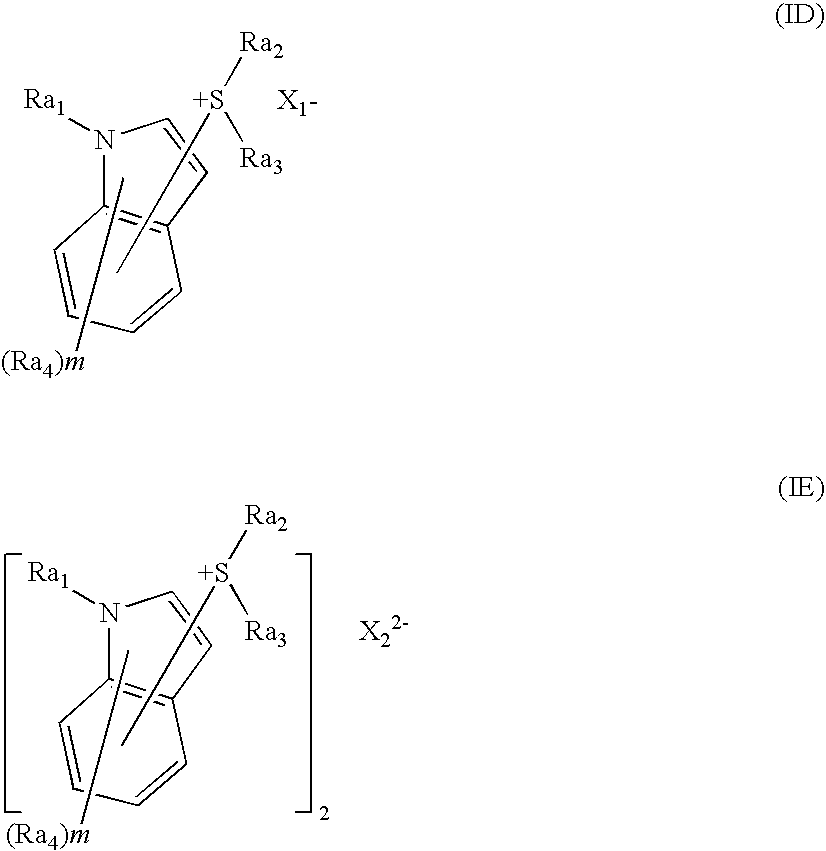Photosensitive composition, compound used in the same, and patterning method using the same
a composition and compound technology, applied in the field of photosensitive compositions, compound used in the same, and patterning methods using the same, can solve the problems of insufficient chemical amplification resist compositions and insufficient chemical amplification systems that have not yet been developed, and achieve the effect of improving exposure latitude and line-edge roughness
- Summary
- Abstract
- Description
- Claims
- Application Information
AI Technical Summary
Benefits of technology
Problems solved by technology
Method used
Image
Examples
synthesis example 1
Synthesis of Compound (I-1)
[0404] Into 200 ml of chloroform, 7.2 g of indole and 12.5 g of diphenyl sulfoxide were dissolved and cooled to −30° C. in a stream of nitrogen. To this solution, 25.8 g of trifluoroacetic anhydride was added dropwise over a 30-minute period. The temperature of the admixture was raised to room temperature, and reaction was run for 4 hours. To this reaction mixture was added a water solution containing 81 g of sodium tetrafluoroborate. The chloroform phase was washed with water, and concentrated to yield crude crystals. These crystals were washed with ethyl acetate to give 15.9 g of 3-indolyldiphenylsulfonium tetrafluoroborate.
[0405] A 10 g portion of the 3-indolyldiphenylsulfonium tetrafluoroborate was dissolved in 100 ml of acetonitrile, and thereto was added 9.1 g of potassium nonafluorobutanesulfonate dissolved in an acetonitrile / water mixture. Chloroform was added to the resulting reaction solution, and the chloroform phase was washed with water, and...
synthesis example 2
Synthesis of Compound (I-17)
[0408] Into 150 ml of chloroform, 7.2 g of indole and 6.6 g of tetramethylene sulfoxide were dissolved and cooled to −30° C. in a stream of nitrogen. To this solution, 11.8 g of trifluoroacetic anhydride was added dropwise over a 30-minute period. The temperature of the admixture was raised to room temperature, and reaction was run for 4 hours. To this reaction mixture was added 20 g of potassium nonafluorobutanesulfonate dissolved in an acetonitrile / water mixture. The chloroform phase was washed with water, and concentrated to yield crude crystals. These crystals were washed with diisopropyl ether to give 14.8 g of Compound (I-17).
[0409] NMR Spectrum of Compound (I-17)
[0410] 300 MHz 1H-NMR (DMSO-d6): δ 2.2 to 2.5 (m. 4H), δ 3.6 to 4.0 (m. 4H), δ 7.2 to 7.4 (m. 2H), δ 7.61 (d. 1H), δ 7.78 (d. 1H), δ 8.34 (d. 1H), δ 12.58 (bs. 1H)
synthesis example 3
Synthesis of Compound (I-18)
[0411] Into 100 ml of chloroform, 5 g of 1-methylindole and 3.9 g of tetramethylene sulfoxide were dissolved and cooled to −30° C. in a stream of nitrogen. To this solution, 8 g of trifluoroacetic anhydride was added dropwise over a 30-minute period. The temperature of the admixture was raised to room temperature, and reaction was run for 4 hours. To this reaction mixture was added 13.5 g of potassium nonafluorobutanesulfonate dissolved in an acetonitrile / water mixture. The chloroform phase was washed with water, and concentrated to yield crude crystals. These crystals were recrystallized from a 1:5 mixture of ethyl acetate and diisopropyl ether to give 7.5 g of Compound (I-18).
[0412] NMR Spectrum of Compound (I-18)
[0413] 300 MHz 1H-NMR (CDCl3): δ 2.4 to 2.9 (m. 4H), δ 3.6 to 4.1 (m. 4H), δ 3.94 (s. 3H), δ 7.3 to 7.5 (m. 3H), δ 7.65 (d. 1H), δ 8.31 (d. 1H)
[0414] Other acid generators were synthesized similarly to the above.
[0415] The structure and th...
PUM
| Property | Measurement | Unit |
|---|---|---|
| temperature | aaaaa | aaaaa |
| temperature | aaaaa | aaaaa |
| temperature | aaaaa | aaaaa |
Abstract
Description
Claims
Application Information
 Login to View More
Login to View More - R&D
- Intellectual Property
- Life Sciences
- Materials
- Tech Scout
- Unparalleled Data Quality
- Higher Quality Content
- 60% Fewer Hallucinations
Browse by: Latest US Patents, China's latest patents, Technical Efficacy Thesaurus, Application Domain, Technology Topic, Popular Technical Reports.
© 2025 PatSnap. All rights reserved.Legal|Privacy policy|Modern Slavery Act Transparency Statement|Sitemap|About US| Contact US: help@patsnap.com



